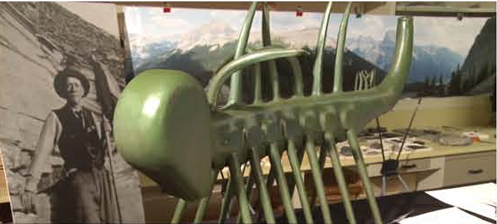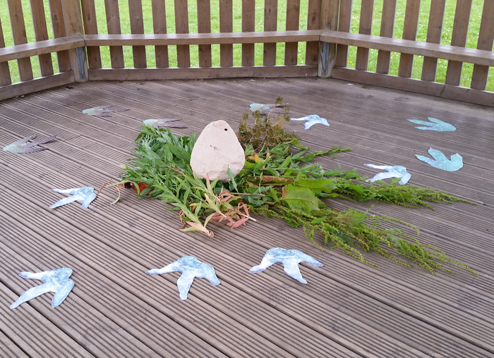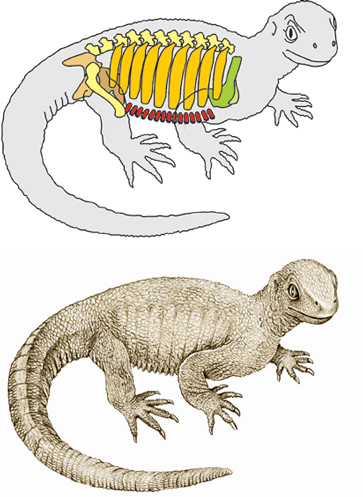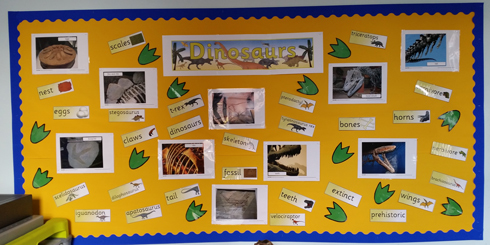Bizarre Hallucigenia Gets a Face
Growing up with an interest in fossils and prehistoric life, for many team members at Everything Dinosaur, meant that during their formative years, one of the most bizarre of all the animals that are known to have existed, would periodically enter their lives. The mysterious Hallucigenia, fossils of which are found in the famous Burgess Shale deposits of British Columbia, would have a new research paper published and there would be a fresh perspective on this most peculiar looking creature.
Fossils of the Very Mysterious and Bizarre Hallucigenia

A fossil of Hallucigenia (Burgess Shale)
Burgess Shale Fossils
The facial features and the mouth of this little animal have finally been revealed. A study conducted by scientists Dr Martin Smith (Cambridge University) and Dr Jean-Bernard Caron (Curator of Invertebrate Palaeontology, Royal Ontario Museum, Canada), has led to some of the mysteries surrounding Hallucigenia being resolved. For example, we know now which end was the head and which end was the tail. In addition, electron microscopy has shown that Hallucigenia had a ring of teeth inside its mouth and a further set of teeth running down its throat.
These teeth in the throat probably served as ratchets. Palaeontologists think that the tube like body of Hallucigenia was designed to digest food that it sucked into the opening at the front of its body, the simple mouth. The teeth in the throat may have helped to push food particles down the gut as well as preventing food from being sucked out again as the animal pumped in mud and water as part of its feeding mechanism.
This previously unidentified feature (a throat lined with needle-like teeth), helps connect this Cambrian sea creature to extant Velvet Worms and the evolution of the arthropods, which today make up more than 80% of all the animal life on Earth.
Hallucigenia
Commenting on the discovery of Hallucigenia’s facial features, Dr Smith explained:
“When we put it into the electron microscope, we were delighted to see not just a tiny pair of eyes looking back at us, but also beneath them a really cheeky semi-circular smile. It was as if the fossil was grinning at us at the secrets that it had been hiding.”
This new study into Hallucigenia, the first fossils of which were found by Charles Walcott who discovered the Burgess Shale fossil site in 1909, has also solved another mystery. Although, specimens are relatively rare in the Burgess Shale biota, a number of fossils that have been found show a tear shaped blob preserved adjacent to the body. For some years, this was thought to be the head, or possibly some sort of appendage of the animal. However, the new paper, published in the journal “Nature”, identifies these strange blobs as gut contents.
Dr Smith stated:
“What our study shows is that it [the blob] has a different composition from the animal. And rather than representing part of its body, it actually represents decay fluid – the contents of its guts – squeezed out as the animal was buried and fossilised.”
What was that Mysterious Blob?

A Hallucigenia specimen (Royal Ontario Museum).
Picture credit: Royal Ontario Museum/Dr. Jean Bernard Caron with additional annotation by Everything Dinosaur
The arrow in the picture shows the location of the strange blob.
A Rare Fossil
Compared to the bountiful fossils of other species associated with the Burgess Shale Formation, Hallucigenia fossils are rare, so much so that the first species to be formerly described in the Hallucigenia genus was named H. sparsa. It was English palaeontologist Simon Conway Morris who established the Hallucigenia genus after he reviewed the earlier Walcott study. Walcott had thought that this little animal was some form of early bristle worm (polychaete worm), like a Lugworm, but Conway Morris decided that this creature was so unique it deserved its own genus. He established the genus Hallucigenia, so named for its “bizarre and dream-like appearance”.
Like a number of other Burgess Shale animals, Hallucigenia was thought to be an evolutionary experiment that left no descendants. The Cambridge University/Royal Ontario Museum team have been able to map, approximately where the alien-looking Hallucigenia fits into the Kingdom Animalia. It seems to be a precursor to the Velvet Worms (Onychophorans), that still can be found in the tropics today. Velvet Worms, arthropods and Tardigrades (Water Bears), belong to a huge group of animals that all moult, these are called Ecdysozoans.
Establishing the Phylogeny of Hallucigenia
The researchers were able to establish that Hallucigenia was not the common ancestor of these moulting animals but that it was an ancestor of the extant Onychophorans. Finding the mouth and the pharyngeal teeth (teeth in the throat), helped the scientists to determine that Velvet Worms originally had the same configuration, but these were eventually lost.
Dr Smith explained:
“The early evolutionary history of this huge group is pretty much uncharted. While we know that the animals in this group are united by the fact that they moult, we haven’t been able to find many physical characteristics that unite them”.
Dr Jean-Bernard Caron added:
“It turns out that the ancestors of moulting animals were much more anatomically advanced than we ever could have imagined, ring-like, plate-bearing worms with an armoured throat and a mouth surrounded by spines. We previously thought that neither Velvet Worms nor their ancestors had teeth. But Hallucigenia tells us that actually, Velvet Worm ancestors had them, and living forms just lost their teeth over time.”
Team members at Everything Dinosaur have a lot of time for the Hallucigenia genus. Most of the individuals are much smaller than people imagine. The largest specimens are around thirty-five millimetres in length and when Conway Morris published his research in 1979, it turns out that his study depicted this animal the wrong way up and back to front.
Remembering Early Reconstructions
Conway Morris illustrated Hallucigenia as walking on stiff spine-like legs, with a single row of tentacles waving around on its back. A model was created that showed this new view of Hallucigenia. The model can be seen at the start of the Royal Ontario Museum video featuring Dr Caron who explains about the latest research. Although, anatomically not correct, the model remains a curiosity that is kept at the Museum along with a large number of Burgess Shale specimens including many of the fossils collected by Charles Walcott.
The Original Simon Conway Morris Model of Hallucigenia

The very alien-looking Hallucigenia model.
Picture credit: Royal Ontario Museum
The bulbous head turns out to be the rear end of the creature and thanks to this new research (plus some similar types of Chinese fossils that have been extensively studied), we have a very different interpretation of this marine creature. It looks quite graceful and delicate. A picture of Charles Walcott can be seen in the background.
Based on the New Research The Reconstructed Hallucigenia

Scientists have been able to stare into the face of Hallucigenia for the first time.
Picture credit: Danielle Dufault
Spines Evolved as Defensive Structures
Those spines, once thought to be legs probably evolved as a number of predators shared Hallucigenia’s marine habitat. The spines would have been an effective deterrent against attacks from nektonic arthropods.
Hallucigenia remains one of the most remarkable animals within the Burgess Shale biota, but thanks to this new study some of the mysteries surrounding it have been solved. It remains an enigmatic little creature and after more than a century since its discovery it is still capable of springing a few surprises. The story of Hallucigenia and how it has been interpreted and reinterpreted over the years provides a fascinating example of how new techniques and study methods can lead to a reinterpretation of the fossil evidence.
CollectA have recently introduced a range of not-to-scale replicas of important animals from the Palaeozoic. To review this range of models and figures: CollectA Prehistoric World Models.
























